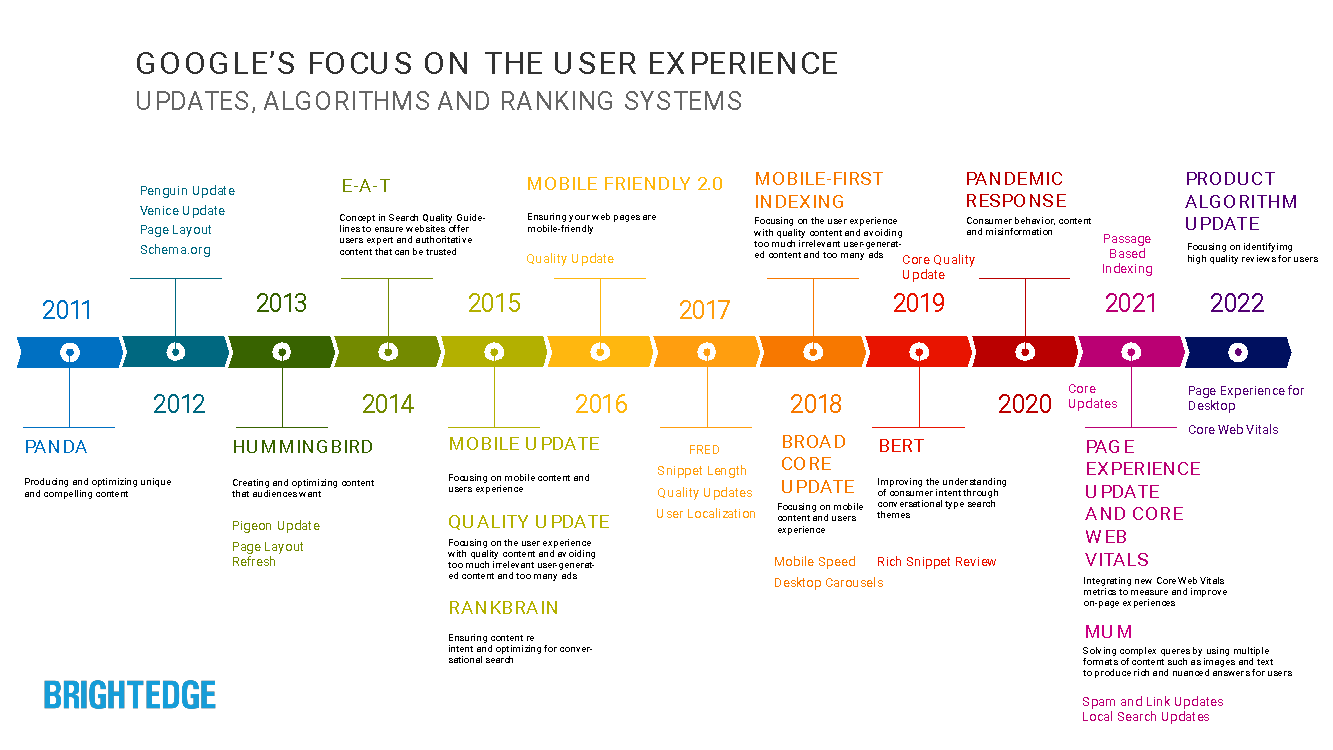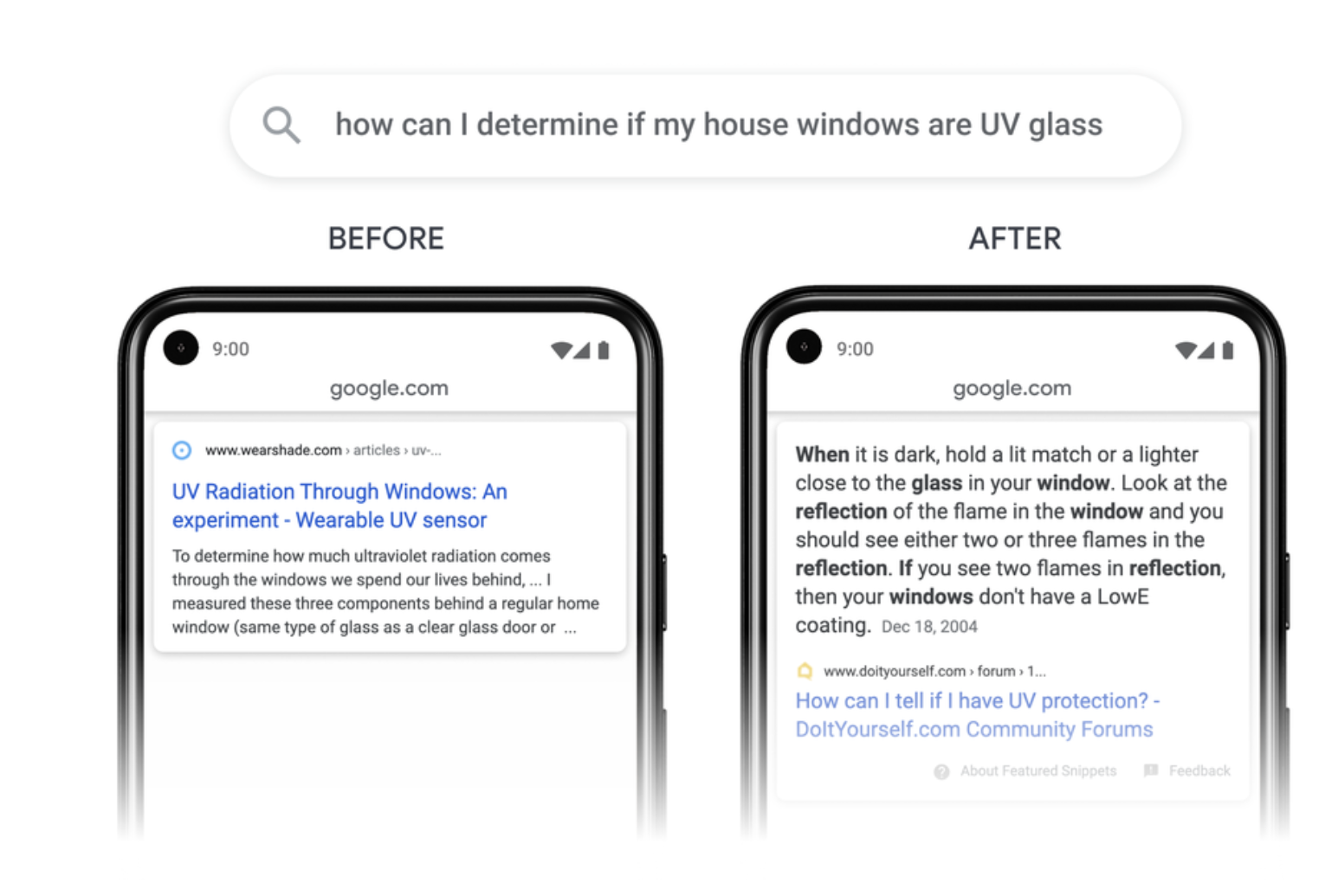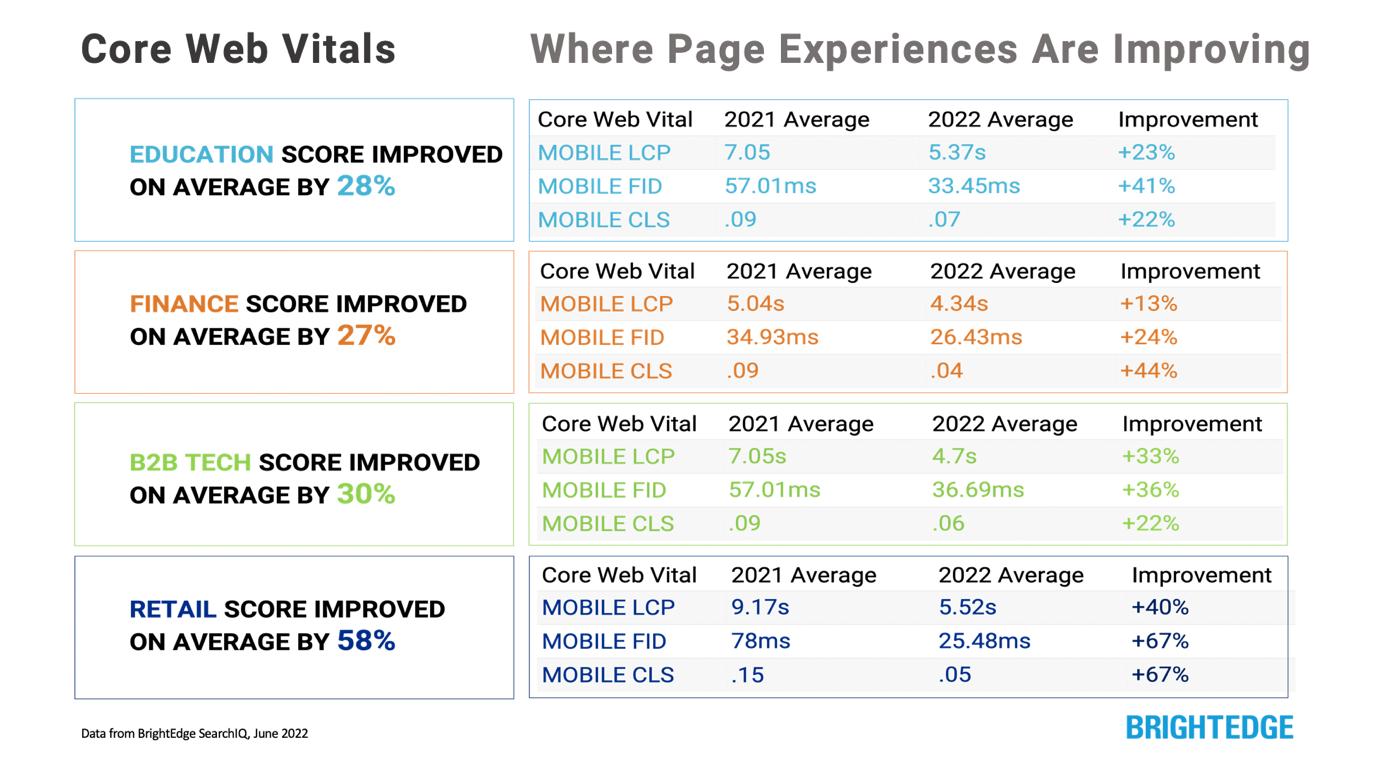As the role of search evolves to touch multiple marketing and consumer touchpoints, optimizing for the user has never been so important.
This is reflected in Google’s continual focus on the searcher experience. Whether in its core algorithmic updates, new features, products, or SERP format changes.
While some of these Google changes have involved updates targeting low-quality content, links, and spam, other updates aim to understand consumer behavior and intent.
For example, most recent updates have focused on page speed, Core Web Vitals, and product reviews.
Considering the massive competition for SERP real estate from brands, even slight drops in position will critically impact traffic, revenue, and conversions.
In this article, I examine a combination of some (not all) Google updates and technological advancements that significantly reflect the search engine’s focus on the human user and their experiences online – from Panda in 2011 through to Page and Product Experience in 2021 and 2022.
Google Panda (2011)
First launched in February 2011, subsequent updates were continuous and added to Google’s core algorithm.
Panda was announced to target sites with low-quality content; this was one of the first signals that Google focused on content for the user experience.
The focus: producing and optimizing unique and compelling content.
- Avoid thin content and focus on producing high-quality information.
- Measure quality over quantity.
- Content length is not a significant factor but needs to contain information that answers the user’s needs.
- Avoid duplicate content – initially a big concern for ecommerce sites. Most recently, Google’s John Mueller explained that duplicate content is not a negative ranking factor.
Google Hummingbird (2013)
Following the introduction of the Knowledge Graph came Hummingbird with a focus on semantic search.
Hummingbird was designed to help Google better understand the intent and context behind searches.
As users looked to enter queries more conversationally, it became essential to optimize for user experience by focusing on content beyond the keyword with a renewed focus on the long tail.
This was the first indication of Google using natural language processing (NLP) to identify black hat techniques and create personalized SERP results.
The focus: creating and optimizing content that audiences want and find helpful.
- Long-tail keywords and intent model strategies became crucial.
- Content creation is needed to address what users are interested in and would like to learn.
- Expand keyword research to include conceptual and contextual factors.
- Avoid keyword-stuffing and producing low-quality content to personalize experiences.

E-A-T (2014)
Although it gained attention in 2018, the Google E-A-T concept first appeared in 2014 in Google’s Quality Guidelines.
Now, it is part of Google’s guidelines on focusing on YMYL – your money or your life.
Marketers were advised to focus on content that could impact their readers’ future happiness, health, financial stability, or safety.
Google established E-A-T guidelines to help marketers tailor on and off-page SEO and content strategies to provide users with an experience containing the most relevant content from sources they could trust.
In other words: Expertise, Authority, and Trust.
The focus: ensuring websites offer expert and authoritative content that users can trust.
- Create content that shows expertise and knowledge of the subject matter.
- Focus on the credibility and authority of websites publishing content.
- Improve the overall quality of websites – structure and security.
- Earn off-page press coverage on reputable sites, reviews, testimonials, and expert authors.
Mobile Update (2015)
This was the first time Google gave marketers a heads-up (or a warning, for many) that an update was coming.
Focusing on the user’s experience on mobile was a significant signal reflecting the growing use of mobile as part of the customer search journey.
Google clearly communicated that this update would prioritize mobile-friendly websites on mobile SERPs. Many more mobile updates followed.
The focus: mobile content and users’ mobile site experience.
- Focus on design factors such as responsive design and mobile page structures.
- Enhance site navigation, so mobile users can quickly find what they need.
- Avoid format issues on mobile that were different from the desktop experience.
- Confirm that websites are mobile-optimized.
Just after the mobile update went live, Google quietly issued a Quality update.
Websites that focused on the user experience by focusing on quality content and avoiding too much irrelevant user-generated content and too many ads did well. This was another sign that Google was putting the user experience first.
RankBrain (2015)
Like the Hummingbird principles and NLP mentioned earlier, Google RankBrain was more of a change to the algorithm.
It gave us an indication of how vital machine learning was in all marketing and technology forms.
Utilizing this to learn and predict user behavior, RankBrain powered search results based on an even better understanding of users’ intent.
The focus: ensuring that content reflects user intent and optimizing for conversational search.
- Place greater focus and emphasis on creating content that matches the user’s intent.
- Ensure that all aspects of technical SEO are updated (such as schema markup, for example).
- Google signified that RankBrain was the third-most important ranking signal.
Google Mobile-First Indexing (2018)
The Mobile-First Indexing Update meant that Google would use the mobile version of a webpage for indexation and ranking.
Once again, this was aimed to help enhance the user experience and help users find what they are looking for.
Producing content for mobile and focusing on speed and performance became paramount to success.
The focus: re-affirming the importance of mobile optimization, content, speed, and mobile site performance.
- Improve AMP and mobile page speed and performance.
- Ensure that URL structures for mobile and desktop sites meet Google requirements.
- Add structured data for both desktop and mobile versions.
- Make sure the mobile site contains the same content as the desktop site.
Google has said that March 2021 is the rollout date for its mobile-first index.
Shortly afterward, Google made mobile page speed a ranking factor so website owners would focus on load times and page speed to enhance the user experience.
Broad Core Algorithm Updates (2018)
2018 was a year in which Google released lots of core algorithm updates covering areas such as social signals and the so-called medic update.
After the August update, in particular, Google’s John Mueller suggested making content more relevant.
While there was some confusion on ranking factors and fixing specific issues, it did bring the concept of E-A-T and content for the user top of mind for many SEO professionals and content marketers.
On the topic of rater guidelines being key to the broad update, Google’s Danny Sullivan suggested:
“Want to do better with a broad change? Have great content. Yeah, the same boring answer. But if you want a better idea of what we consider great content, read our raters guidelines. That’s like almost 200 pages of things to consider.”
BERT (2019)
Following RankBrain, this neural network-based method for natural language processing allowed Google to understand conversational queries better.
BERT allows users to find valuable and accurate information more easily.
According to Google, this represented the most significant leap forward in the past five years and one of the greatest in search history.
The focus: improving the understanding of consumer intent through conversational type search themes.
- Increase the depth and specifics of the content.
- Work more with long-tail queries and phrases using more than three words.
- Ensure that content addresses the users’ questions or queries and is optimized correctly.
- Focus on writing for humans clearly and concisely so that it is easy to understand.
Read more on BERT and SMITH here.
COVID-19 Pandemic (March 2020)
The global pandemic meant that consumer behavior and search patterns changed forever as Google continued to focus on E-A-T signals.
Google began to emphasize YMYL signals as the internet struggled to cope with misinformation and SEO pros struggled to keep up with the rapid shifts and dips in consumer behavior.
From setting up 24-hour incident response teams with the World Health Organization and policing content to helping people find helpful information and avoiding misinformation, the user’s needs never became so important.
The demand for SEO rose to an all-time high, and Google released a COVID-19 playbook.
Google Page Experience Update And Core Web Vitals Announced (May 2020)
Focusing on a site’s technical health and metrics to measure the user experience of a page metrics include looking at how quickly page content loads, how quickly a browser loading a webpage can respond to a user’s input, and how unstable the content is as it loads in the browser.
The focus: integrating new Core Web Vitals metrics to measure and improve on-page experiences.
- Mobile-friendliness, safe browsing, HTTPS, and intrusive interstitials – The Google Page Experience Signal.
- LCP (Largest Contentful Paint): Improve page load times for large images and video backgrounds.
- FID (First Input Delay): Ensure your browser responds quickly to a user’s first interaction with a page.
- CLS (Cumulative Layout Shift): Include the size attributes on your images and video elements or reserve the space with CSS aspect ratio boxes and ensure content is never inserted above existing content, except in response to user interaction.
Broad Core Algorithm Updates (2020)
The third Google core algorithm update of the year rolled out in December 2020. This came in the form of slight changes that affect the order and weight of certain (not always disclosed) ranking signals.
According to SEJ Contributor Ryan Jones:
“Google aims to serve content that provides the best and most complete answers to searchers’ queries. Relevance is the one ranking factor that will always win out over all others.”
Read more on December’s Core Update here.
Passage Ranking (February 2021)
Google officially rolled out its passage-based indexing, designed to help users find answers to specific questions.
You’ve probably seen this in the wild, but essentially this allows Google to highlight pertinent elements of a passage within a piece of content that fits the question.
This means long-form content that may not be skimmable but provides valuable answers could be surfaced as a result.
Ultimately, this makes it easier for Google to connect users to content without making them hunt for the specific answer to their questions when they click on a page.

The key to success with passage ranking goes back to focusing on creating great content for the user.
Read more on the 16 Key Points You Should Know here.
Product Reviews Update (April 2021)
This new product review update was designed to improve a user’s experience when searching for product reviews.
Marketers were advised to focus on avoiding creating thin content as this update will reward content that users find most helpful.
The focus: rewarding creators who provide users with authentic and detailed review content
Google shared nine helpful questions to consider when creating and publishing product reviews.
- Show expert knowledge about products.
- Differentiate your product compared to competitors.
- Highlight benefits and any drawbacks clearly and concisely.
- Show how the product has evolved to fit the needs of the user.
Read more here.
MUM (May 2021)
Following RankBrain and BERT, MUM (Multitask Unified Model) technology utilizes AI and NLP to improve information retrieval.
For the end user, this technological advancement helps provide better information and results as it processes multiple media formats such as video, images, and audio.
Pandu Nayak, Google fellow and vice president of Search, said:
“But with a new technology called Multitask Unified Model, or MUM, we’re getting closer to helping you with these types of complex needs. So in the future, you’ll need fewer searches to get things done.”
Read more here.
Page Experience Update And Core Web Vitals (CWV) Rollout (June 2021)
The much-anticipated Page Experience Update, including Core Web Vitals, rolled out, with further updates to desktop following in March 2022.
Nine months after the rollout of Google’s Core Web Vitals and over a year since BrightEdge launched pre-roll predictive research, new research showed how many industries are adapting and improving their Core Web Vitals.
The focus: improving Pages Experiences for users with speed and precision.

- Retail giants have made significant strides in improving experiences.
- In cases like Retail, CWV metrics like input delay have been cut in half.
- Although Finance was the best prepared last year, it made the least performance gains in the categories evaluated.
Spam Update (June 2021) And Link Spam Algorithm Update (July 2021)

Ensuring users get the right results based on their searches is foundational to a good experience.
In addition, updates and algorithm changes help protect users’ privacy to keep searches safe and secure.
The focus: keeping user experiences safe.
Learn more in this video from Google here.
Local Search Update (November 2021))
Google has always provided local search updates for local search users and fine-tuned its algorithm for better user results.
Local search is a huge channel, not to be underestimated, but a whole other post.
This also includes guidance on how businesses can improve their local ranking for improved customer experiences.
Read more here.
Product Algorithm Update (March 2022)
On March 23, 2022, Google provided an instruction update based on how product reviews are performing in one year.
This also informed the community of improved rollout updates that will help users surface accurate and relevant information to help with purchasing decisions.
The focus: user experience and surfacing results that help users make purchasing easier.

- As always, showcase your expertise and ensure the content is authentic.
- Share why you recommend products with evidence to support it.
Read more advice here and here.
Conclusion
A successful user experience requires a combination of content and technical expertise. Updates and guidance help marketers create content for the user.
In addition, algorithms and technological advancements help Google surface better results and showcase accurate, relevant, and trustworthy content.
Google will continue to focus on improving experiences for its user.
As a marketer who wants to optimize for both, ensuring your website (from navigation, speed, and reliability) and focusing on content is vital.
Many of Google’s updates signal that technical SEO, data science, and content marketing excellence are coming together.
Stay up to date and read through all of Google’s Updates here on SEJ.
More Resources:
- Google Uses Different Algorithms For Different Languages
- How Search Engine Algorithms Work: Everything You Need To Know
- SEO For Beginners: An Introduction To SEO Basics
Featured Image: Gorodenkoff/Shutterstock


